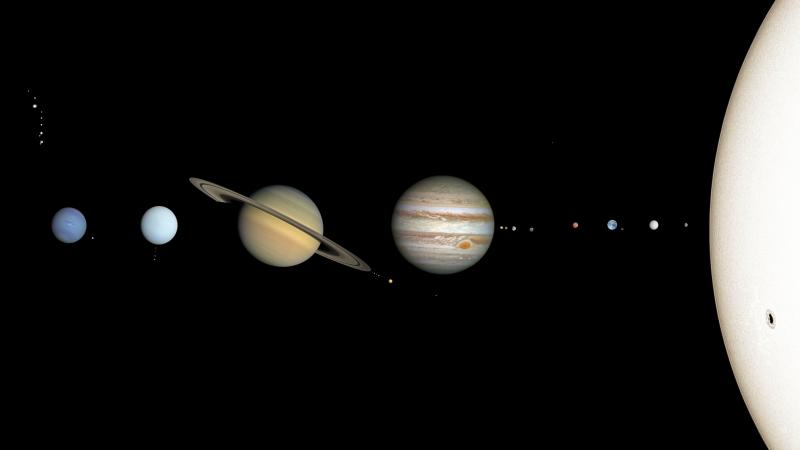Introduction

Solar system (distances not to scale)
CC-SA https://en.wikipedia.org/wiki/File:Solar_System_true_color.jpg
Our solar system consists of our star, the Sun, and everything bound to it by gravity – the planets Mercury, Venus, Earth, Mars, Jupiter, Saturn, Uranus, and Neptune; dwarf planets such as Pluto; dozens of moons; and millions of asteroids, comets, and meteoroids. Modern day space exploration wouldn’t be possible without programming and computer science!
NASA is currently developing space robots that use artificial intelligence to travel through the solar system.
The future is space!
Task

Programming 3d graphics
Public Domain: https://openclipart.org/detail/190653/programming-sphere
NASA and ESA are looking to recruit more scientists and programmers for their space exploration projects. But there’s a problem. They’re programmers, not physicists! NASA have tasked you with making a Planet Fact File Program to help teach prospective programmers about our solar system!
This exercise will guide to create program that gives interesting facts about our solar system. Thus, at the same time, you will learn the many interesting facts about the planets, dwarf planets or the Sun.
The Planet Fact File program can be used to many other topics also, perhaps to store your best cooking recipes, or let it be your diary.
Furthermore, Java is the multipurpose language, that can be used in almost any machine; even on your mobile. Thus, it might be possible to use a similar Planet Fact File Program on your Android Device.
The Links and Videos given here provide a lot of information about Sun, our planets and our solarsystem. Watch the videos, try the links and learn many many interesting facts about our solar system. Though it seems that we know a lot of our solar system, there is a lot of things to explore. The journey is still in the beginning.
Process
In this project you will be making a planet fact file. In this project we will:
- Research and gather facts about the planets in the solar system
- Allow the user to select the planet they would like to find more about
- Getting information from an external file, show the user a fact file about that planet.
- Start by creating a new Java Project. This is described in page 5 of the enclosed document Planet Fact file.pdf.
- Create the main method with the help of pages 9-11. The main method is used to read the information about the planets and prints (or writes) it to the screen.
- Create one Planet Fact file. Page 16 shows an example of one planet fact file, which is to be read by the main function. The creation of new files using Eclipse IDE is shown on pages 12-13.
- Make more planet fact files; the information of one planet is given on a one file, thus you will need 8 separate fact files to finish this tutorial. You can use the links provided at the Links section at this to find out information about our solar system. Note that you should use many independent references. Stay on the facts.
- Choose the fact file that is shown by your program. The example is shown on page 17. Steps 7-9 visualizes how to interact with the external files. This is an important and rather complicated part of the code.
- Finally, step 10 at page 20 prints the fact file on the screen. Note how the subroutine is used here.
The Links and Videos given here provide a lot of information about Sun, our planets and our solarsystem. Watch the videos, try the links and learn many many interesting facts about our solar system. Though it seems that we know a lot of our solar system, there is a lot of things to explore. The journey is still in the beginning.
Conclusion
- You should know how to store information on a separate file or multiple files. That makes it easy to give tasks to different people, and spread the amount of work for colleagues.
- You can find interesting facts about our solar system, and share the information with your school mates, or colleagues using the Planet Fact File program.
Next steps:
- You should try to make your own fact file system. Apply it to store cooking recipes, or make a phone number catalogy.
- Try to include images in the fact file. How is that possible?
- Learn more about Java programming using the links and videos provided.
- Move to Level 2 Java programming in other Modules (Arts, Humanities, Mathematics).
Links to everyday life:
- Some of the planets are visible in the evening, or early in the morning, or during the night.
- The space robots, or rovers on the planets, are of great interest. We need the rovers to study the planets; eg. the properties of soil or mars quakes.
- The storms in Mars help to us to create better weather forecasts in Earth.
Learning Objectives
Learning Objectives
- You know how to use loops in Java.
- You have memorized the basic facts about the planets in our solar system.
- You can read information from external files.
- You are able to write a Fact File on almost any topic.
- You can apply programming skills to a real life problem.
- You know how to search for relevant information on multiple sources.
- You can create a menu that the user can interact with.





